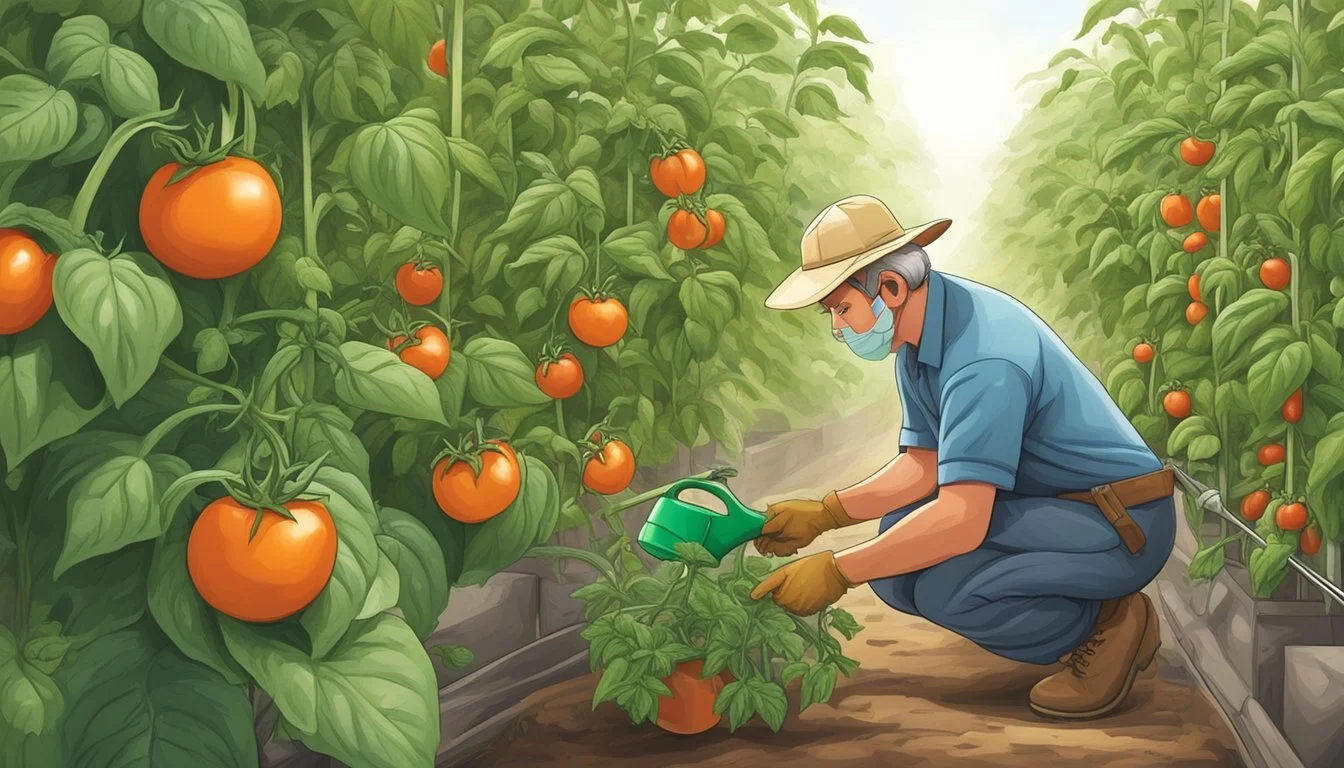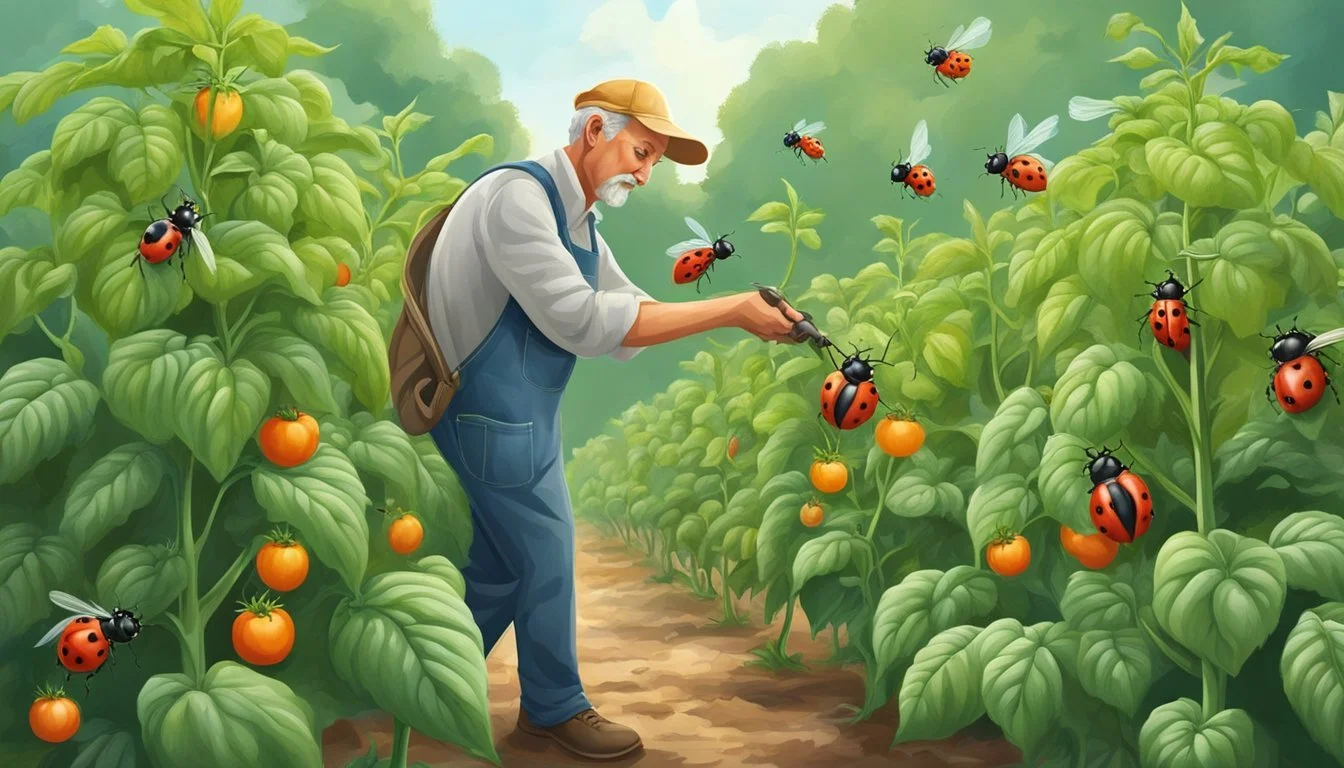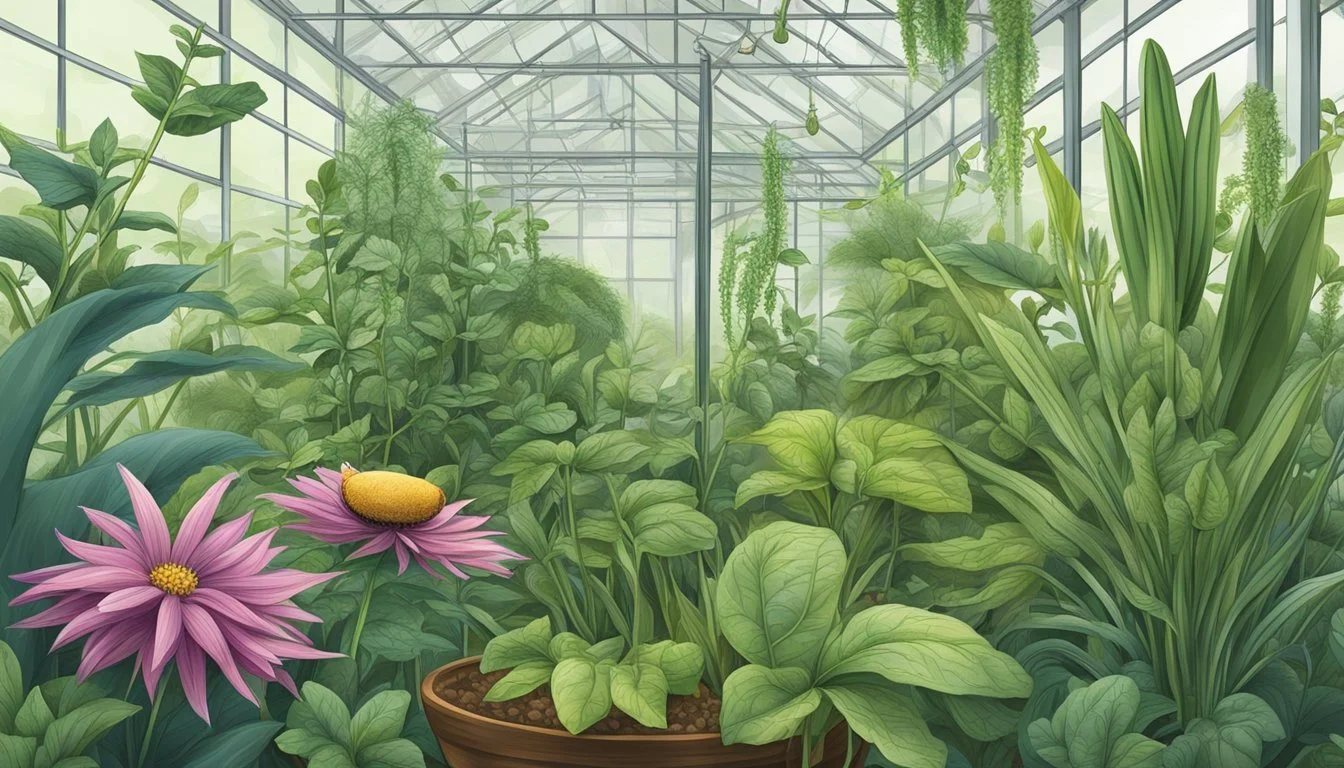Protecting Crops from Tomato Bugs
Effective Strategies for Gardeners
Tomato plants are a staple in many gardens due to their versatile use in culinary dishes and relatively low maintenance. However, one of the significant challenges tomato growers face is the multitude of pests that can besiege these plants. From hornworms to aphids, these pests can not only damage the plants and reduce the yield but can also make the tomatoes less aesthetically pleasing, affecting sale prospects for commercial growers.
Employing effective pest control measures is crucial for protecting tomato crops. Methods range from traditional chemical pesticides to more eco-friendly options like companion planting and introducing beneficial insects. Awareness of pest behavior, life cycles, and vulnerabilities can be instrumental in creating a solid strategy for pest management.
Gardeners often take preemptive actions to ensure the health of their tomato plants by implementing practices such as regular inspections, proper plant spacing for airflow, and soil maintenance. Adhering to these practices often results in stronger plants that are better equipped to resist pests and other related diseases, thereby enabling a bountiful and healthy crop.
Understanding Tomato Pests
Tomato pests can significantly impact the health and yield of tomato plants. Effective pest management starts with identification, understanding their life cycles, and recognizing the potential damage they can inflict.
Identifying Common Tomato Bugs
Tomato plants are susceptible to several insects that can be detrimental to their health. Aphids are small, soft-bodied insects that typically congregate on the undersides of leaves and can stunt plant growth by sucking the sap. Whiteflies, another common pest, resemble tiny white moths and cluster on the undersides of leaves. They excrete a sticky substance called honeydew that can lead to sooty mold. Caterpillars and hornworms are larger pests that consume the leaves and fruit of tomato plants, which can be seen by the noticeable holes they leave behind.
Life Cycle of Tomato Pests
Understanding the life cycle of tomato pests is crucial for effective control. Many of these pests, including aphids and whiteflies, can reproduce rapidly in warm conditions. For example, the tomato hornworm, a type of caterpillar, goes through a complete metamorphosis starting from eggs laid on the underside of leaves. Identifying and interrupting this cycle is key in preventing infestations from maturing and causing extensive damage.
Impact of Pests on Tomato Plants
Pests pose a significant threat to tomato plants, diminishing both the quality and quantity of the harvest. Both aphids and whiteflies can transmit plant viruses, while the chewing of caterpillars and hornworms can defoliate plants and leave fruits vulnerable to sunscald and secondary infections. Additionally, the feeding activity of many bugs can lead to weakened plants that are less productive and more prone to diseases.
Cultural Practices for Pest Prevention
The implementation of cultural practices is crucial for the prevention of pests in tomato cultivation. Strategic actions focused on the choice of plant varieties, crop rotation, and companion planting can significantly reduce the risk of pest infestations.
Selecting Resistant Varieties
Choosing tomato varieties that are resistant to pests is a foundational step in protecting crops. These varieties have been bred to possess genetic traits that make them less susceptible to common pests. By prioritizing soil health and selecting robust varieties, gardeners can create an unfriendly environment for pests, often limiting their impact before they become a substantial problem.
Importance of Crop Rotation
Crop rotation is an effective strategy in disrupting the life cycle of pests that would otherwise thrive in a static environment. By rotating tomatoes with non-solanceous crops like marigolds or basil, gardeners can prevent the buildup of tomato-specific pests in the soil. This approach is beneficial not only for managing pests but also for maintaining soil fertility and reducing disease transmission.
Using Companion Planting
Companion planting is the strategic placement of certain plants in close proximity to enhance mutual growth and pest protection. Plants like marigolds, nasturtiums, and basil can deter pests, while chives, with their strong scent, can mask the smell of tomato plants, making it harder for pests to locate them. Companion plants may also attract beneficial insects that prey on tomato pests, thus contributing to a balanced garden environment.
By integrating these practices, gardeners foster a healthy garden ecosystem that naturally minimizes the presence of detrimental pests without relying heavily on chemical interventions.
Physical Pest Control Methods
Effective physical pest control is essential in safeguarding tomato crops from persistent pests like tomato hornworms, cutworms, and various birds that can cause significant damage. These control methods include deploying barrier methods and utilizing manual removal techniques. They offer a direct approach to preventing and reducing pest populations without the use of chemicals, relying instead on physical obstacles and human intervention.
Deploying Barrier Methods
Row Covers: Gardeners often use floating row covers made of lightweight material to create a physical barrier that excludes pests from reaching the tomato plants. They are particularly effective against birds and cutworms, allowing air, light, and moisture to reach the plants while keeping pests out.
Aluminum Foil: A reflective mulch such as aluminum foil can deter aphids and whiteflies. When placed around the base of tomato plants, it can also confuse and discourage cutworms due to the reflection of light.
Cardboard Collars: Placing cardboard collars around the base of tomato plants can provide a sturdy barrier against cutworms, preventing them from curling around the stem and causing damage to young plants.
Manual Removal Techniques
Handpicking: Gardeners can regularly inspect tomato plants for pests like tomato hornworms and remove them by hand. This technique is immediate and effective, though it requires vigilance and consistent effort.
Encouraging Beneficial Predators: Encouraging predators such as spiders and parasitic wasps can naturally keep pest populations in check. They are allies in the garden, preying on many common pests that harm tomato plants.
Biological Pest Control Strategies
Biological pest control strategies harness nature's own methods to manage pest populations in tomato crops, focusing on introducing or augmenting beneficial organisms that prey upon or parasitize pests.
Encouraging Beneficial Insects
Beneficial insects such as ladybugs, parasitic wasps, and other predatory insects play a crucial role in controlling pests like aphids and mites. Ladybugs, for example, are voracious predators of aphids, a common tomato pest found in gardens and on farms. By planting nectar-rich flowers, growers can attract and sustain these beneficial insects, ensuring they remain in the tomato crop environment to continue their pest control role.
Ladybugs: Consume large quantities of aphids, whiteflies, and mites.
Parasitic Wasps: Lay eggs in or on pests, with larvae that feed on the host, eventually killing it.
Pollinators: While not directly involved in pest control, they are essential for the reproduction of plant allies.
Using Parasitic Nematodes
Beneficial nematodes are microscopic, soil-dwelling organisms that prey on various soil-dwelling insect pests. When applied to the soil, these nematodes seek out and infect pests by entering their bodies. Once inside, they release symbiotic bacteria that kill the host insect. These methods are particularly effective against soil-borne larvae of pests that affect tomatoes.
Beneficial nematodes: Target soil-dwelling insect larvae, reducing future generations of pests.
Chemical Pest Control Solutions
The effectiveness of protecting tomato crops hinges on the judicious use of chemical controls. This section illuminates the role of both organic and synthetic insecticides in the arsenal against tomato pests.
Understanding Organic Insecticides
Organic insecticides, such as insecticidal soap and neem oil, offer growers a way to tackle pest issues with compounds that are generally considered safer for the environment. Insecticidal soap, when applied correctly, targets the soft bodies of pests like aphids and mites, causing them to dehydrate and die. The active components affect only the insects that come in direct contact with the substance, minimizing collateral damage. Similarly, neem oil not only acts as a potent insecticide but also plays a role as a fungicide, disrupting the life cycle of pests and preventing the occurrence of fungal diseases. For those committed to organic pest control, these horticultural oils are staple tools in maintaining crop health.
Application and Safety of Synthetic Insecticides
Synthetic insecticides provide a powerful defense against a broader range of tomato pests. Suppliers strictly regulate the concentration levels to ensure maximum efficacy while posing minimal risks to humans and non-target species. When applying synthetic insecticides, farmers must follow label instructions to protect themselves and the environment. Proper application techniques can include targeted spraying, ensuring coverage is thorough yet limited to affected areas to avoid unnecessary exposure. Lastly, the integration of synthetic insecticides into an overall pest management strategy should be done with care to preserve beneficial insect populations that contribute to the natural suppression of pest species.
Monitoring and Maintaining Plant Health
Successful crop protection hinges on proactive health monitoring and maintenance practices. Plant vitality is crucial for not only growth but also resistance to pests.
Recognizing Early Signs of Infestation
Leaves and stems serve as early indicators of pest infestation. Gardeners must stay vigilant and regularly inspect their tomato plants for tell-tale signs. These include yellowing leaves, a classic symptom of distress, and curling edges, which could signify the presence of pests or diseases. Additionally, abnormalities in the sap or growth patterns should prompt immediate investigation to prevent further damage.
Look for:
Discoloration (yellowing or browning)
Curling or wilting leaves
Holes or chewed edges
Sticky residue or sap on stems
Essential Plant Nutrients and Watering Practices
A balanced supply of nutrients is essential for robust plant health and defense against pests. It is particularly important to ensure that tomato plants receive appropriate levels of nitrogen, phosphorus, and potassium. Hydration also plays a pivotal role; both overwatering and underwatering can stress plants and make them more vulnerable to bugs.
Nutrient Checklist:
Nitrogen: For leaf growth
Phosphorus: For root and flower development
Potassium: For overall vigor
Maintaining a consistent and appropriate watering schedule is equally important. Using tools like soil moisture meters can help to monitor and ensure optimal hydration levels.
Watering Tips:
Water at the base, not the foliage
Early morning watering to prevent fungal diseases
Adjust according to weather conditions and soil type
Plant selection can further bolster health; choosing varieties known for their resistance to pests can be a significant advantage. Regular maintenance, combined with keen observation and prompt action, allows for healthy crops less susceptible to the detriments of tomato bugs.
Harvest and Post-Harvest Strategies
Effective management during the harvest and post-harvest phases is crucial in protecting crops from tomato bugs. The focus lies on employing precise harvesting techniques and implementing robust storage methods to mitigate pest infestations and payload damage.
Proper Harvesting Techniques
Proper harvesting techniques play a pivotal role in minimizing the risks of tomato bug infestations. It is essential to harvest tomatoes at the right maturity stage, as overly ripe fruits are more susceptible to opportunistic pathogens. Timely and careful harvesting prevents damage to the tomato skin, which can serve as an entry point for pests and diseases. Using sanitized tools and handling the payload with care will also help in reducing the chances of contamination.
Storage and Preservation Methods
Once tomatoes are harvested, maintaining the integrity of the storage environment becomes the next critical step in pest management. Traditional storage structures need to carry out extensive research to enhance their capacity and efficiency against pest invasions. For effective tomato cultivation storage, employing improved preservation methods such as the use of chlorination is suggested to ensure food safety and product quality. Furthermore, cool and dry conditions can deter the proliferation of tomato bugs and extend the shelf life of the harvested payload.
Advancements in Tomato Pest Management
Recent advancements in tomato pest management have led to the development of both pest resistant tomato variants and innovative pest management technologies. These strategies aim to reduce crop losses and optimize pest management.
Research on Pest Resistant Tomato Variants
Research has been at the forefront of combating tomato pests by identifying and developing pest resistant tomato variants. Scientists have been employing classical breeding and genetic engineering methods to produce tomato plants that can withstand common pests. These efforts have given rise to varieties that exhibit resistance to pests such as the notorious tomato pinworm, which can be particularly harmful in certain regions such as Florida as described on UF/IFAS Extension.
Innovative Pest Management Technologies
On the technological side, innovative pest management technologies have become game-changers. These include the integration of advanced monitoring systems using sensors to detect pest presence and activity levels precisely. Additionally, the adoption of safer, targeted pesticides that minimize harm to natural enemies of tomato pests is a key component of an Integrated Pest Management (IPM) approach supported by research from ScienceDirect. The use of beneficial insects has also become an essential biological control method.
Through these methods, growers can maintain healthier tomato crops and mitigate the impact of pests more effectively than ever before.
Community and Regulatory Aspects
When addressing crop protection from tomato bugs, the support of local gardening communities and adherence to agricultural regulations play crucial roles. Collaborative efforts and regulatory compliance ensure effective, safe, and sustainable pest control strategies are implemented.
Local Gardening Community Support
The local gardening community can be a bastion of support for gardeners facing issues with tomato pests. These communities often share collective knowledge on best practices for natural pest control methods, reducing reliance on potentially harmful chemicals. For instance, experienced gardeners may share insights on companion planting, which can deter pests without harming the ecosystem. Workshops and community meetings serve as valuable platforms for exchanging information on organic solutions like neem oil or insecticidal soaps known to control the spread of pests effectively.
Following Agricultural Regulations
Gardeners must stay abreast of and follow the latest agricultural regulations to ensure their pest control methods are legal and environmentally responsible. Regulations could include approved pesticides, application methods, and guidelines for protective equipment while applying treatments. For example, the Environmental Protection Agency (EPA) oversees pesticide use, ensuring that gardeners and commercial growers alike adhere to safety standards to protect human health and the environment. Non-compliance not only risks legal repercussions but also could contribute to broader issues such as pest resistance and environmental contamination.
Conclusion
Protecting tomato plants from insects is vital for ensuring a healthy and bountiful harvest. Gardeners have several strategies at their disposal to combat these pests effectively. Among these are the use of netting, which acts as a physical barrier against birds and larger insects, as elucidated in Netting Tomatoes: A Comprehensive Guide to Protecting Your Crop.
The application of diluted soapy water is a gentle yet effective means of deterring smaller insects, which serves the dual purpose of pest control and disease prevention. Detailed instructions on the correct dilution can be found at the following resource: How to Keep Bugs Off a Tomato Plant.
In the fight against pests, crop rotation plays a crucial role, as it helps prevent the accumulation of soil-borne pests and diseases. Clean gardening practices such as the removal of debris and weeds also contribute to a bug-free environment. To dive deeper into these methods, interested individuals can visit Managing Tomato Pests: Comprehensive Guide.
Furthermore, it’s important to note that spacing tomato plants adequately can significantly curtail pest infestations by enhancing air circulation and reducing the humidity that many bugs find appealing. For more insights, one might explore the tips offered by House Digest.
Ultimately, the health of tomato plants is the best line of defense. A strong plant is better equipped to withstand pest invasions and can often outgrow minor damage. Maintaining moist, mulched, and nutrient-rich soil promotes vigorous plant growth, enhancing natural resilience to pests.
Frequently Asked Questions
Effective pest management for tomato plants involves preventative strategies and targeted responses to infestations. This section addresses common concerns with practical advice for protecting tomato crops.
How can I naturally prevent pests on my tomato plants?
Gardeners can prevent pests naturally by practicing crop rotation to avoid pest buildup and introducing beneficial companion plants like marigolds that repel certain insects.
What is the best insecticide for treating pest infestations on tomato crops?
For chemical control, gardeners should select insecticides labeled for use on tomato pests. It's critical to follow the manufacturer's instructions for application rates and safety.
How can I identify and control the major insect pests of tomatoes?
Identification is key. For example, the tomato fruitworm is a common pest that damages fruits. Control can include regular monitoring and the use of appropriate insecticides or biological controls.
How do I effectively eliminate black bugs from my tomato plants?
Managing black bugs, such as aphids, involves natural predators like ladybugs, spraying soapy water or using insecticidal soaps made specifically for these pests.
What are some proven methods to keep bugs off of my tomato plants organically?
Organic methods include using floating row covers to block pests and applying a mixture of water and mild dish soap to deter insects without using synthetic chemicals.
What are common diseases and pests in tomatoes and how can they be managed?
Common issues include blights, wilts, and pests such as hornworms and whiteflies. Strategies for management include maintaining healthy soil, removing infected plants, and employing natural or chemical controls tailored for the specific problem.





